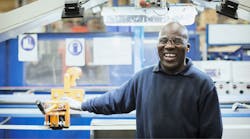CNH Industrial-Saskatoon's Tech-Focused Safety in the Spotlight of NSC's Latest Research
In the latest National Safety Council’s report, "Emerging Technologies for the Prevention of Musculoskeletal Disorders" they underscore key advancements reshaping workplace safety. As Industry 4.0 evolves, the report signals the transition to Industry 5.0, accentuating the synergy of human creativity with technological progress. CNH Industrial's Saskatoon plant exemplifies this approach, a strategy that notably aligns with the core findings of the NSC's recent report.
When CNH Industrial's Saskatoon plant faced a trend of back injuries, they turned to wearable technology and computer vision technology to not only address the problem but also set new safety standards.
From Buzzes to Breakthroughs
One of the highlights of the NSC report is the emphasis on wearable sensors as instrumental tools, especially in contexts where engineering solutions might strain budgets, aiding in curtailing posture-related injuries. These wearables, armed with real-time haptic feedback (buzzes), hold promise in drastically reducing injuries from poor postures and flawed ergonomics.
By the end of 2021, CNH Industrial's Saskatoon plant logged 10 OSHA-recordable back injuries. Linette Fetter, EHSE Manager, realized this was a challenge they couldn't ignore. In early 2022 they adopted the SoterCoach wearable technology. The program was piloted with approximately 200 workers from the highest-risk departments, places where most recordable injuries had been noted.
The tech proved invaluable in two significant ways:
- Worker Education: The real-time feedback, through buzzes and beeps, informed workers about risky motions or postures that they may not have realized were harmful.
- Identifying Ergonomic Risks: Tasks that seemed innocuous were spotlighted for the ergonomic threats they posed, especially when repeated frequently.
One particular testimonial came from a welder, who was initially frustrated by the device's alerts. Rather than dismissing it, he proactively found a solution: a specialized stool. This tool not only stopped the buzzing but dramatically improved his posture and reduced his injury risk.
"The workers found it enlightening that performing the same overhead motion daily didn’t initially appear detrimental. Yet, the regularity of this action, highlighted by the device's alerts, offered an eye-opener." — Linette Fetter, EHSE Manager at CNH-Saskatoon
The Results: 10 to Zero Injuries
By the end of the program's first year, back injuries weren't just reduced; they were eradicated. Furthermore, the program's efficacy led CNH-Saskatoon to broaden the technology's use, first by addressing shoulder MSD injuries and later by considering its expansion to other departments and CNH sites.
Transforming Vision into Strategy
The NSC's research highlights the significant potential of computer vision, especially for large organizations by offering a means to aggregate and deeply scrutinize ergonomic risks.
In line with this vision, CNH-Saskatoon has adopted the SoterTask AI-vision processing technology. The goal is to meticulously craft physical demand descriptions that adhere to Canadian Standards Associations (CSA) and Saskatchewan regulations, further fortifying their commitment to ensuring a safe workplace.
They're employing AI to simplify and enhance the process. Key AI-driven improvements include:
- Efficiently measuring object weights.
- Swiftly identifying risk factors.
- Building an exhaustive library of physical demand descriptions.
"The positive results and the potential for continued improvements in workplace safety are amazing. We're harnessing AI technology to confirm risk factors more efficiently. It's fascinating how AI technology mirrors what my brain perceives. I'm eager to see its continued evolution in enhancing workplace safety." — Linette Fetter, EHSE Manager at CNH-Saskatoon
Towards Industry 5.0: Merging Human Creativity with Automation
The NSC nudges industries toward the horizon of Industry 5.0. This new phase places emphasis on harmonizing human ingenuity with mechanized processes, ensuring that advancements in technology empower rather than overshadow the workforce.
CNH-Saskatoon’s endeavors, from adopting AI tools to the hands-on modifications made by its workers, beautifully encapsulate this harmony. A welder's intuitive response to the SoterCoach's alerts – the acquisition of a posture-enhancing stool – mirrors the future that the NSC envisions: a world where human creativity and technological advancements meld in a symbiotic dance.
Author:
Toni-Louise Gianatti
Toni-Louise is dedicated to improving communication between technology and manual laborers to enhance safe and efficient body movements. With qualifications in human anatomy, business, and leadership, and 30 years as a certified functional movement practitioner, she's a global authority on transformative movement practices. Currently at Soter Analytics, her work—backed by over 50 published works—focuses on promoting workplace safety and injury-free movement through technology.
